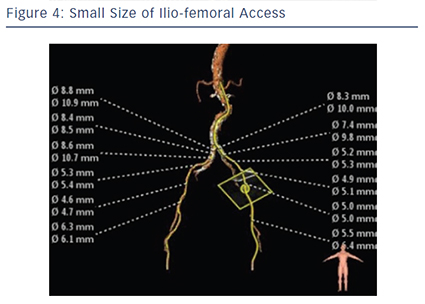
Vascular access is also an important factor in small body sized patients undergoing TAVI. Smaller vascular access increases the sheath to femoral artery ratio, resulting in a higher risk of vascular complications,12 which have been shown to be associated with a significant increase in mortality.12–14 Our previous report showed the incidence of major vascular complications was significantly higher in the small body size group compared with the normal body size group because of the smaller access (13.0 % versus 4.3 %; p<0.01).7 Care should be taken to avoid vascular complications in patients with smaller ilio-femoral access (see Figure 4). New emerging TAVI technologies with lower-profile sheath system, SAPIEN 3 (Edwards Lifesciences Inc., Irvine, CA, US) and Evolut R (Medtronic, Santa Rosa, California, US) have the potential to reduce the risk of vascular complications.15,16
Due to the smaller access route, a non-femoral approach is preferred in patients with smaller anatomy. In recent results of national registry, non-femoral access was one of the significant predictors of adverse outcome.17 Using the newer and lower-profile sheath TAVI system, femoral access will be used more frequently and encourage the prevalence of TAVI for patients with smaller anatomy.